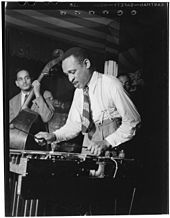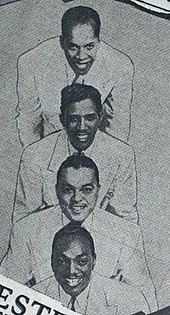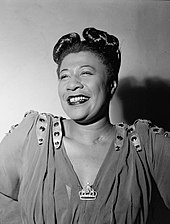List of Most Played Juke Box Race Records number ones of 1946

In 1946,
In the issue of Billboard dated January 5, Joe Liggins and his Honeydrippers were at number one with "The Honeydripper" (Parts 1 & 2). The track had spent 17 weeks at number one in 1945 and thus achieved a final total of 18 weeks at number one, a new record for an R&B chart-topper. Louis Jordan and his Tympany Five equalled the record in the final issue of 1946 when their song "Choo Choo Ch'Boogie" spent an 18th week in the top spot. The record would also be equalled by Drake's "One Dance" in 2016 but not broken until "Old Town Road" by Lil Nas X spent a 19th week atop the modern Hot R&B/Hip Hop Songs chart in 2019.[4][5] Jordan dominated the top of the chart during 1946, spending a total of 34 weeks in the top spot (including two in which he tied for number one with another act) with five songs, one of which was a collaboration with singer Ella Fitzgerald.
The longest unbroken run at number one in 1946 was achieved by vibraphone player Lionel Hampton and his Orchestra, who spent 14 consecutive weeks in the top spot with "Hey! Ba-Ba-Re-Bop", including one tied week. In June, pioneering black vocal harmony group the Ink Spots achieved their fifth and final number one with "The Gypsy"; the song also reached the top spot on the all-genre Best-Selling Popular Retail Records, Records Most-Played on the Air and Most-Played Juke Box Records charts.[6][7] The year's final number one was Jordan's "Choo Choo Ch'Boogie"; including his collaboration with Fitzgerald, Jordan had occupied the top spot without interruption since July. He was by far the most successful artist of the 1940s on Billboard's R&B charts. His tally of 18 chart-toppers was a record which would stand until the 1980s, and he spent 113 weeks at number one,[a] a record which would still stand in the 21st century.[4] Jordan's success fell away in the 1950s, but his music is considered to have been hugely influential on the development of both R&B and rock and roll.[8]
Chart history



| Issue date | Title | Artist(s) | Ref. |
|---|---|---|---|
| January 5 | "The Honeydripper" (Parts 1 & 2) | Joe Liggins and his Honeydrippers | [9] |
| January 12 | "Buzz Me" | Louis Jordan and his Tympany Five | [10] |
| January 19 | [11] | ||
| January 26 | [12] | ||
| February 2 | [13] | ||
| February 9 | [14] | ||
| February 16 | [15] | ||
| February 23 | [16] | ||
| March 2 | |||
| March 9 | [17] | ||
| March 16 | "Hey! Ba-Ba-Re-Bop" | Lionel Hampton and his Orchestra | [18] |
| March 23[b] | "Don’t Worry 'bout That Mule" | Louis Jordan and his Tympany Five | [19] |
| "Hey! Ba-Ba-Re-Bop" | Lionel Hampton and his Orchestra | [19] | |
| March 30 | [20] | ||
| April 6 | [21] | ||
| April 13 | [22] | ||
| April 20 | [23] | ||
| April 27 | [24] | ||
| May 4 | [25] | ||
| May 11 | [26] | ||
| May 18 | [27] | ||
| May 25 | [28] | ||
| June 1 | [29] | ||
| June 8 | [30] | ||
| June 15 | [31] | ||
| June 22 | [32] | ||
| June 29 | "The Gypsy" | The Ink Spots | [33] |
| July 6 | "Hey! Ba-Ba-Re-Bop" | Lionel Hampton and his Orchestra | [34] |
| July 13 | "The Gypsy" | The Ink Spots | [35] |
| July 20[b] | "Stone Cold Dead in the Market" | Ella Fitzgerald and Louis Jordan and his Tympany Five | [36] |
| "The Gypsy" | The Ink Spots | [36] | |
| July 27 | "Stone Cold Dead in the Market" | Ella Fitzgerald and Louis Jordan and his Tympany Five | [37] |
| August 3 | [38] | ||
| August 10 | [39] | ||
| August 17 | [40] | ||
| August 24 | "Choo Choo Ch'Boogie" | Louis Jordan and his Tympany Five | [41] |
| August 31 | [42] | ||
| September 7 | [43] | ||
| September 14 | [44] | ||
| September 21 | [45] | ||
| September 28 | [46] | ||
| October 5 | [47] | ||
| October 12 | [48] | ||
| October 19 | [49] | ||
| October 26 | [50] | ||
| November 2 | [51] | ||
| November 9 | [52] | ||
| November 16 | [53] | ||
| November 23 | "Ain't That Just Like a Woman" | [54] | |
| November 30 | "Choo Choo Ch'Boogie" | [55] | |
| December 7 | [56] | ||
| December 14 | [57] | ||
| December 21 | [58] | ||
| December 28 | [59] |
Notes
a. ^ Jordan's first 16 number ones occurred at a time when Billboard published only one R&B chart. His final two number ones occurred during a period when the magazine published two charts and each topped both listings, but the figure of 113 weeks at number one does not double-count weeks when he topped both.[60]
b. ^ Two songs tied for the number one position.
References
- ^ Whitburn 1996, p. xii.
- ^ Molanphy, Chris (April 14, 2014). "I Know You Got Soul: The Trouble With Billboard's R&B/Hip-Hop Chart". Pitchfork. Archived from the original on January 21, 2019. Retrieved December 19, 2021.
- ^ Cole, Tom (November 2, 2013). "Paramount Records: The Label Inadvertently Crucial To The Blues". NPR. Archived from the original on January 11, 2021. Retrieved January 27, 2021.
- ^ a b Whitburn 2004, p. 783.
- ^ Fekadu, Mesfin (August 12, 2019). "Lil Nas X's 'Old Town Road' sets more records on Billboard charts". USA Today. Archived from the original on March 8, 2022. Retrieved January 29, 2021.
- ^ Whitburn 2004, p. 275.
- ^ Dahl, Bill. "The Ink Spots Biography & History". AllMusic. Archived from the original on May 3, 2017. Retrieved January 30, 2021.
- ^ Dahl, Bill. "Louis Jordan Biography & History". AllMusic. Archived from the original on February 18, 2021. Retrieved January 11, 2021.
- from the original on February 27, 2022. Retrieved February 27, 2022.
- from the original on February 27, 2022. Retrieved February 27, 2022.
- from the original on February 27, 2022. Retrieved February 27, 2022.
- from the original on February 27, 2022. Retrieved February 27, 2022.
- from the original on February 27, 2022. Retrieved June 21, 2018.
- from the original on February 27, 2022. Retrieved June 21, 2018.
- from the original on February 27, 2022. Retrieved June 21, 2018.
- from the original on February 27, 2022. Retrieved June 28, 2018.
- from the original on February 27, 2022. Retrieved June 28, 2018.
- from the original on February 27, 2022. Retrieved June 28, 2018.
- ^ from the original on February 27, 2022. Retrieved June 28, 2018.
- from the original on May 11, 2016. Retrieved June 28, 2018.
- from the original on February 27, 2022. Retrieved June 28, 2018.
- from the original on February 27, 2022. Retrieved June 28, 2018.
- from the original on February 27, 2022. Retrieved June 28, 2018.
- from the original on February 27, 2022. Retrieved June 28, 2018.
- from the original on February 27, 2022. Retrieved June 28, 2018.
- from the original on February 27, 2022. Retrieved June 27, 2018.
- from the original on February 27, 2022. Retrieved February 27, 2022.
- from the original on February 27, 2022. Retrieved June 27, 2018.
- from the original on February 27, 2022. Retrieved June 27, 2018.
- from the original on February 27, 2022. Retrieved June 27, 2018.
- from the original on February 27, 2022. Retrieved June 27, 2018.
- from the original on February 27, 2022. Retrieved June 27, 2018.
- from the original on February 27, 2022. Retrieved June 27, 2018.
- from the original on February 27, 2022. Retrieved June 27, 2018.
- from the original on February 27, 2022. Retrieved June 27, 2018.
- ^ from the original on February 27, 2022. Retrieved June 27, 2018.
- from the original on February 27, 2022. Retrieved June 27, 2018.
- from the original on February 27, 2022. Retrieved June 27, 2018.
- from the original on February 27, 2022. Retrieved June 27, 2018.
- from the original on February 27, 2022. Retrieved June 27, 2018.
- from the original on February 27, 2022. Retrieved June 27, 2018.
- from the original on June 4, 2016. Retrieved June 27, 2018.
- from the original on February 27, 2022. Retrieved June 27, 2018.
- from the original on February 27, 2022. Retrieved June 29, 2018.
- from the original on February 27, 2022. Retrieved June 29, 2018.
- from the original on February 27, 2022. Retrieved June 29, 2018.
- from the original on February 27, 2022. Retrieved June 29, 2018.
- from the original on February 27, 2022. Retrieved June 29, 2018.
- from the original on February 27, 2022. Retrieved June 27, 2018.
- from the original on February 27, 2022. Retrieved June 18, 2018.
- from the original on February 27, 2022. Retrieved February 27, 2022.
- from the original on February 27, 2022. Retrieved February 27, 2022.
- from the original on February 27, 2022. Retrieved February 27, 2022.
- from the original on February 27, 2022. Retrieved February 27, 2022.
- from the original on February 27, 2022. Retrieved February 27, 2022.
- from the original on February 27, 2022. Retrieved February 27, 2022.
- from the original on February 27, 2022. Retrieved February 27, 2022.
- from the original on February 27, 2022. Retrieved February 27, 2022.
- from the original on February 27, 2022. Retrieved February 27, 2022.
- ^ Whitburn 2004, pp. 309–310.
Works cited
- ISBN 978-0-89820-115-4.
- ISBN 978-0-89820-160-4.
